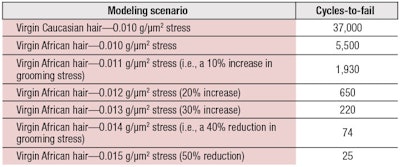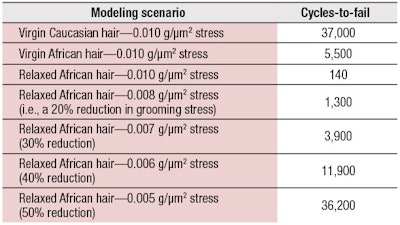
Read this article in its entirety in the June 2020 digital edition. . .
Individual hair fibers come in a variety of sizes, shapes and colors that collectively create the fundamental properties of a head of hair. Most obviously, these features not only dictate visual appearance but they are also behind other important factors, such as manageability and even an ability to attain certain styles. This leads to the popular concept of hair “type,” where certain shared characteristics lead to categorization into broad, general classifications.
The most extreme of these fiber shapes is seen in individuals of African descent wherein fibers, most notably, can possess very tight curls. Further investigation at a microscopic level reveals how these fibers can be overtly elliptical and may contain twists down their lengths to produce a ribbon-like conformation.
This remarkable shape can, however, lead to a variety of issues for the wearer.1 High on this list is a marked propensity for breakage, and efforts to minimize this occurrence result in different hair-related habits and practices for the end user. This article describes recent measurement advances that shed much-needed light on the reason for these issues.
Defining Strengths
It is common to read that African hair is weaker than other hair types2 and Figure 1 shows data from a conventional tensile testing experiment3 that aligns with this belief. However, rarely mentioned is the relatively meager magnitude of this difference.
The tips of shoulder-length Caucasian hair will likely show a similarly sized decrease in break stress due to everyday wear and tear; but excessive breakage is not a problem in this instance for the Caucasian consumer. The extent of the measured difference between the strength of these two hair types is not commensurate with the enormity of the breakage problem for the African consumer.
Fatigue Testing Insights
Insights into this mystery are revealed when assessing hair breakage via the relatively new technique of single fiber fatigue testing.4, 5 This technique involves repeating the application of a relatively small stress with subsequent monitoring of how many cycles are needed to cause breakage. Figure 2 shows the data for the same Caucasian and African hair samples used in Figure 1. Results are expressed as S-N plots, wherein the number of cycles-to-fail (N) is plotted against the magnitude of the repeating stress (S).
The regression lines for the two hair types are essentially parallel, with the line associated with the African hair falling below Caucasian hair. From these relationships, it can be calculated that a repeated, 0.010 g/μm2 stress will induce breakage in Caucasian hair after approximately 37,000 cycles but in African hair, the breakage occurs at only around 5,500 cycles. This sizable difference between the two hair types is more in line with the issue at hand; although the situation for African hair still gets worse, as we see next.
Unrecognized Contributors
Daily grooming similarly constitutes the application of repeated, fatiguing stresses on individual hair strands, and this process is more arduous in tightly curled African hair. In fact, Epps and Wolfram6 reported African hair yielded dry state combing forces that were 10× higher than Caucasian hair; Syed7 suggested a 50× difference. It is therefore not enough to compare the breakage of these two hair types at common repeating stress. Increased fatiguing magnitudes must also be factored.
The downhill slopes of the two plots in Figure 2 illustrate how the repeated action of higher deforming stresses lead to faster breakage but the logarithmic nature of the y axis reveals the exponential nature of this relationship. Table 1 shows modeling based on the regression lines of the S-N plots that illustrate how a comparatively meager 50% increase in grooming stresses further lowers the cycles-to-fail for African hair to alarming levels.
This important influence of the fatiguing stress magnitude on the tendency for breakage is, perhaps, one of the most significant realizations to materialize from the use of this fatigue testing approach. In fact, ongoing internal modeling work consistently shows how hair insult scenarios pertaining to increased friction, i.e., higher grooming/fatiguing stresses, outweigh traditionally considered factors associated with a weakening cortex (data not shown). This influential relationship, in combination with the much higher grooming forces associated with African hair, yields cause for concern.
Relaxing Thoughts
Thus far, the present article has only discussed virgin African hair but the practice of hair relaxing, i.e., chemically treating hair to relax is tightly coiled nature, is a historically-popular practice associated with this hair type, as it affords the wearer access to a greater variety of hairstyles. Such chemical straightening/relaxing involves highly caustic formulations that greatly compromise the hair’s tensile strength. To this end, it is puzzling to hear many consumers report that they use this process to help reduce their hair breakage.
Fatigue testing can provide an explanation for this apparent contradiction. Figure 3 shows S-N plots for both virgin and chemically relaxed African hair. As illustrated, the regression lines are parallel, and the heightened tendency for breakage is hair in the relaxed state. Continuing with the previous modeling strategy, it is calculated that a repeating 0.010 g/μm2 stress causes relaxed African hair to break after 140 fatiguing cycles.
However, this relaxing process makes grooming considerably easier and so a reduction in grooming forces must be factored. Table 2 exemplifies how the exponential nature of the S-N curve works in favor of hair as the tendency for breakage is curtailed. For example, despite the sizable weakening effect of caustic relaxer products, the model predicts how a simultaneous attainment of a 40% reduction in grooming forces would net-out to fibers requiring approximately twice the number of fatiguing cycles-to-fail as the virgin African hair. There is, however, one other cause for concern still lurking within Figure 2.
Premature Breakage
Figure 2 illustrates the overall higher tendency for breakage in African hair; on further inspection, however, the reader may notice that many African hair fibers survive equally long as Caucasian fibers at a specific condition. So, not all African hair fibers are weaker. On the other hand, a significant number of African hair fibers break after very few fatiguing stokes, i.e., less than 100—even less than 10. In the fatigue world, these are termed premature failures and are notably absent from the Caucasian dataset.
On top of the circumstances already described that predict the worrisome average breakage levels for African hair, a percentage of these fibers will further undergo premature failure and break much faster. From this work, approximately 10% of African hair fibers breaking prematurely appears to be a rough but reasonable estimate. For perspective, a typical head of hair is thought to contain between 100,000 to 150,000 individual fibers. Therefore, at any given time, 10,000-15,000 fibers in a head of African hair are likely to be premature breakers.
. . .Read more in the June 2020 digital edition. . .
References
- Bryant, H., Porter, C. and Yang, G. (2012). Curly hair: Measured differences and contributions to breakage. Int J of Dermatology 51(Suppl. 1) 8-11.
- Bryant, H. and Porter, C.E. (2013, Aug). Hair Ethnicity, in practical modern hair science. Evans, T.A. and Wickett, R.R. Allured Business Media.
- Evans, T.A. (2013, Aug). Measuring hair strength, part 1: Stress-strain curves. Cosmet & Toilet 128(8) 590-594.
- Evans, T.A. (2009). Fatigue testing of hair—A statistical analysis of hair breakage. J Cosmet Sci 60 599-616.
- Evans, T.A. (2013, Dec). Measuring hair strength, part 2: Fiber breakage. Cosmet & Toilet Vol. 128(12) 854-859.
- Epps, J. and Wolfram, L.J. (1983). Letter to the editor. JCosmet.Sci, 34 213-214.
- Syed, A.N., Kuhajda, A., Ayoub, H. and Frank, E.M. (1995). African american hair Cosmet & Toilet 110 39-48.
- Evans, T.A. (2014, Nov 12). Hair as a test substrate in the laboratory. Http://www.cosmeticsandtoiletries.com/testing/efficacyclaims/Hair-as-a-Test-Substrate-premium-282462371.html.
- De la Mettrie, R., Saint-Leger, D., Loussouarn, G., Garcel, A., Porter, C. and Langaney, A. (2007). Shape variability and classification of human hair. Hum Biol 79 265-281.
- Porter, C.E., Dixon, F., Khine, C., Pistorio, B., Bryant, H. and de la Mettrie, R. (2009). The behavior of hair from different countries. J Cosmetic Sci 60 97-109.
Captions/Footnotes:
*This article is a variation of a presentation given by the author at TRI’s one-day Ethnic Hair Symposium that was held in Red Bank, NJ, on Sept. 24, 2019.








!['We believe [Byome Derma] will redefine how products are tested, recommended and marketed, moving the industry away from intuition or influence, toward evidence-based personalization.' Pictured: Byome Labs Team](https://img.cosmeticsandtoiletries.com/mindful/allured/workspaces/default/uploads/2025/08/byome-labs-group-photo.AKivj2669s.jpg?auto=format%2Ccompress&crop=focalpoint&fit=crop&fp-x=0.49&fp-y=0.5&fp-z=1&h=191&q=70&w=340)




